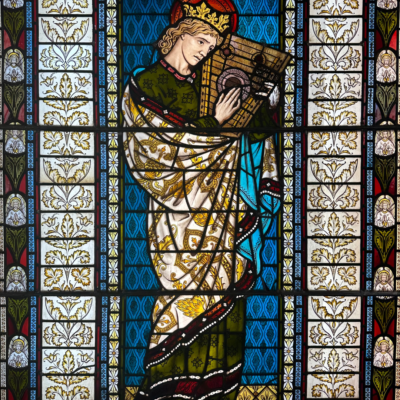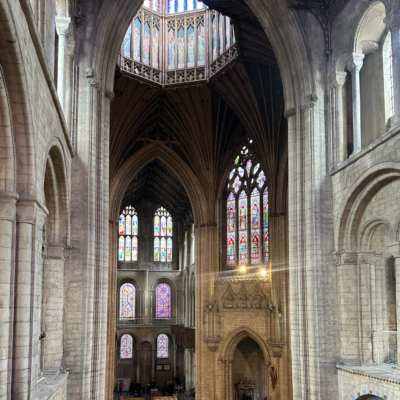Each year, De Morgan Patrons enjoy a day out organised by the De Morgan Foundation to thank them for their support. On these trips, we discover De Morgan’s art in unexpected and remarkable settings. In 2023, we visited the picturesque county of Cambridgeshire, where we had the privilege of visiting William De Morgan’s splendid King David stained glass window at the Stained Glass Museum, housed within the majestic Ely Cathedral. This stained glass masterpiece provides us with a unique window into the early chapters of William De Morgan’s illustrious career, well before he became celebrated for his iconic ceramic creations. To witness this exceptional piece, the only example of De Morgan’s stained glass in a public museum collection, is a rare and exquisite treat.

The King David stained glass window’s journey is as intriguing as its artistry. Originally installed in St Lawrence Whitechurch, Little Stanmore, a historic church in North London, the stained glass panel is a testament to the Victorian-era renovations at the church. However, over a century later, following the advice of the Georgian Society, the church was restored to its original baroque interior. Fortunately, the stained glass window was safeguarded and preserved within the church before finding its current home on long-term loan at Ely Cathedral.
This remarkable stained glass window is part of a series created by De Morgan for St. Lawrence Church, featuring scenes from the oratorios of George Frederic Handel, the esteemed composer. The connection between Handel and the Stanmore area is commemorated through these exquisite depictions. Handel himself lived on the Cannons Estate in Stanmore, enjoying the patronage of the Duke of Chandos, making it fitting that the panels portray moments from his musical compositions.
In the King David stained glass window, we encounter the biblical figure holding a harp. King David’s celebrated musical talents, particularly his skill with the harp, are well documented in the Bible, where he played to soothe the troubled King Saul. This portrayal beautifully captures the harmonious blend of music and spirituality.
De Morgan’s devotion to celebrating the power of music continued with additional stained glass windows depicting Esther and St. Cecilia, the patron saint of music. These window designs pay homage to the profound impact of music on the human spirit and its transformative role in enriching the spiritual experience within the church. The Esther Window, for instance, illustrates scenes from the story of the queen of the Persian King Ahasuerus, a narrative at the heart of the Jewish festival of Purim. Handel’s oratorio, “Esther,” which likely had its origins at the Cannons Estate, is inspired by the same tale.

Our visit to the King David window was an enchanting experience, heightened by its current placement on a balcony high above Ely Cathedral. As we gazed upon the stained glass masterpiece, we could hear choral scholars in practice and the organ playing in the cathedral below. This immersive encounter allowed us appreciate the spirit of De Morgan’s musical masterpiece, and the profound interplay between art, music, and spirituality.






